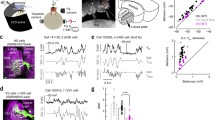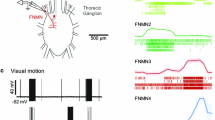Abstract
The functional properties of the three horizontal cells (north horizontal cell, HSN; equatorial horizontal cell, HSE; south horizontal cell, HSS) in the lobula plate of the blowflyCalliphora erythrocephala were investigated electrophysiologically. 1. The receptive fields of the HSN, HSE, and HSS cover the dorsal, equatorial and ventral part of the ipsilateral visual field, respectively. In all three cells, the sensitivity to visual stimulation is highest in the frontal visual field and decreases laterally. The receptive fields and spatial sensitivity distributions of the horizontal cells are directly determined by the position and extension of their dendritic fields in the lobula plate and the dendritic density distributions within these fields. 2. The horizontal cells respond mainly to progressive (front to back) motion and are inhibited by motion in the reverse direction, the preferred and null direction being antiparallel. The amplitudes of motion induced excitatory and inhibitory responses decline like a cosine function with increasing deviation of the direction of motion from the preferred direction. Stimulation with motion in directions perpendicular to the preferred direction is ineffective. 3. The preferred directions of the horizontal cells show characteristic gradual orientation changes in different parts of the receptive fields: they are horizontally oriented only in the equatorial region and increasingly tilted vertically towards the dorsofrontal and ventrofrontal margins of the visual field. These orientation changes can be correlated with equivalent changes in the local orientation of the lattice of ommatidial axes in the pertinent compound eye. 4. The response amplitudes of the horizontal cells under stimulation with a moving periodic grating depend strongly on the contrast frequency of the stimulus. Maximal responses were found at contrast frequencies of 2–5 Hz. 5. The spatial integration properties of the horizontal cells (studied in the HSE) are highly nonlinear. Under stimulation with extended moving patterns, their response amplitudes are nearly independent of the size of the stimuli. It is demonstrated that this response behaviour does not result from postsynaptic saturation in the dendrites of the cells. The results indicate that the horizontal system is essentially involved in the neural control of optomotor torque responses performed by the fly in order to minimize unvoluntary deviations from a straight flight course.
Similar content being viewed by others
References
Beersma, D.G.M., Stavenga, D.G., Kuiper J.W.: Retinal lattice, visual field and binocularities in flies. J. Comp. Physiol.119, 207–220 (1977)
Bishop, L.G., Keehn, D.G., McCann, G.D.: Motion detection by interneurons of the optic lobes and brain of the flies,Calliphora phaenicia andMusca domestica. J. Neurophysiol.31, 509–525 (1968)
Blondeau, J.: Electrically evoked motor activity in the fly, (Calliphora erythrocephala). Dissertation, Universität Tübingen 1977
Blondeau, J.: Electrically evoked course control in the flyCalliphora erythrocephala. J. Exp. Biol.92, 143–153 (1981a)
Blondeau, J.: Aerodynamic capability of flies as revealed by a new technique. J. Exp. Biol.92, 155–163 (1981b)
Blondeau, J., Heisenberg, M.: The three-dimensional optomotor torque system ofDrosophila melanogaster. J. Comp. Physiol.145, 321–329 (1982)
Braitenberg, V.: Periodic structures and structural gradients in the visual ganglia of the fly. In: Information processing in the visual system of arthropods. Wehner, R. (ed.), pp. 1–15. Berlin, Heidelberg, New York: Springer 1972
Dvorak, D.R., Bishop, L.G., Eckert, H.E.: On the identification of movement detectors in the fly optic lobe. J. Comp. Physiol.100, 5–23 (1975)
Eckert, H.: Identifizierte, bewegungssensitive Interneurone als neurophysiologische Korrelate für das Bewegungssehen der Insekten. Verh. Dtsch. Zool. Ges. 1976, p. 253. Stuttgart: Gustav Fischer 1976
Eckert, H.: Anatomie, Elektrophysiologie und funktionelle Bedeutung bewegungssensitiver Neurone in der Sehbahn von Dipteren (Phaenicia). Habilitationsschrift, Universität Bochum 1979
Eckert, H.: Functional properties of the H1-neurons in the third optic ganglion of the blowfly,Phaenicia. J. Comp. Physiol.135, 29–39 (1980)
Eckert, H.: The horizontal cells in the lobula plate of the blowfly,Phaenicia sericata. J. Comp. Physiol.143, 511–526 (1981)
Franceschini, N.: Sampling of the visual environment by the compound eye of the fly: fundamentals and applications. In: Photoreceptor optics, Snyder, A.W., Menzel, R. (eds.), pp. 98–125. Berlin, Heidelberg, New York: Springer 1975
Geiger, G., Nässel, D.R.: Visual orientation behaviour of flies after laser beam ablation of interneurons. Nature293, 398–399 (1981)
Geiger, G. Nässel, D.R.: Visual processing of moving single-objects and wide-field patterns in flies. Biol. Cybern.44, 141–150 (1982)
Götz, K.G., Hengstenberg, B., Biesinger, R.: Optomotor control of wing beat and body posture inDrosophila. Biol. Cybern.35, 101–112 (1978)
Hausen, K.: Struktur, Funktion und Konnektivität bewegungsempfindlicher Interneuronen im dritten optischen Neuropil der SchmeißfliegeCalliphora erythrocephala. Dissertation, Universität Tübingen 1976a
Hausen, K.: Functional characterization and anatomical identification of motion sensitive neurons in the lobula plate of the blowflyCalliphora erythrocephala. Z. Naturforsch.31c, 629–633 (1976b)
Hausen, K.: Funktion, Struktur und Konnektivität bewegungsempfindlicher Interneurone in der Lobula plate von Dipteren. Verh. Dtsch. Zool. Ges. 1976, p. 254. Stuttgart: Gustav Fischer 1976c
Hausen, K.: Signal processing in the inset eye. In: Function and formation of neural systems. Stent, G.S. (ed.), pp. 81–110. Berlin: Dahlem Konferenzen 1977
Hausen, K.: Monocular and binocular computation of motion in the lobula plate of the fly. Verh. Dtsch. Zool. Ges. 1981, pp. 49–70. Stuttgart: Gustav Fischer 1981
Hausen, K.: Motion sensitive interneurons in the optomotor system of the fly. I. The horizontal cells: structure and signals. Biol. Cybern.45, 143–156 (1982)
Hausen, K., Wehrhahn, C.: The role of the horizontal cells in the optomotor yaw torque response in flies (in preparation) (1982)
Heide, G.: Properties of a motor output system involved in the optomotor responses of flies. Biol. Cybern.20, 99–112 (1975)
Heisenberg, M., Wonneberger, R., Wolf, R.: Optomotor-blind — aDrosophila mutant of the lobula plate giant neurons. J. Comp. Physiol.124, 287–296 (1978)
Hengstenberg, R.: Spike responses of non-spiking visual interneurone. Nature270, 338–340 (1977)
Hengstenberg, R.: Common visual response properties of giant vertical cells in the lobula plate of the blowflyCalliphora. J. Comp. Physiol. (in press) (1982)
Mastebroek, H.A.K., Zaagman, W.H., Lenting, B.P.M.: Movement detection: performance of a wide-field element in the visual system of the blowfly. Vision Res.20 467–474 (1980)
McCann, G.D., Dill, J.C.: Fundamental properties of intensity, form, and motion perception in the visual nervous system ofCalliphora phaenicia andMusca domestica. J. Gen. Physiol.53, 355–371 (1969)
McCann, G.D., Foster, S.F.: Binocular interactions of motion detection fibers in the optic lobes of flies. Kybernetik8, 193–203 (1971)
Pick, B.: Visual pattern discrimination as an element of the fly's orientation behaviour. Biol. Cybern.23, 171–180 (1976)
Poggio, T., Reichardt, W., Hausen, K.: A neuronal circuitry for relative movement discrimination by the visual system of the fly. Naturwissenschaften68, 443–446 (1981)
Reichardt, W., Poggio, T., Hausen, K.: Figure-ground discrimination by relative movement in the visual system of the fly. Part II: Towards the neural circuitry (in preparation) (1982)
Soohoo, S.L., Bishop, L.G.: Intensity and motion response of giant vertical neurons in the fly eye. J. Neurobiol.11, 159–177 (1980)
Spüler, M.: Erregende und hemmende Wirkungen visueller Bewegungsreize auf das Flugsteuersystem von Fliegen —Elektrophysiologische und verhaltensphysiologische Untersuchungen anMusca andCalliphora. Dissertation, Universität Düsseldorf 1980
Wehrhahn, C., Hausen, K.: How is tracking and fixation accomplished in the nervous of the fly? Biol. Cybern.38, 179–186 (1980)
Zaagman, W.H., Mastebroek, H.A.K., Kuiper, J.W.: On the correlation model: processing of continuously moving patterns by a movement detecting neural element in the fly visual system. Biol. Cybern.31, 163–168 (1978)
Author information
Authors and Affiliations
Rights and permissions
About this article
Cite this article
Hausen, K. Motion sensitive interneurons in the optomotor system of the fly. Biol. Cybern. 46, 67–79 (1982). https://doi.org/10.1007/BF00335352
Received:
Issue Date:
DOI: https://doi.org/10.1007/BF00335352




